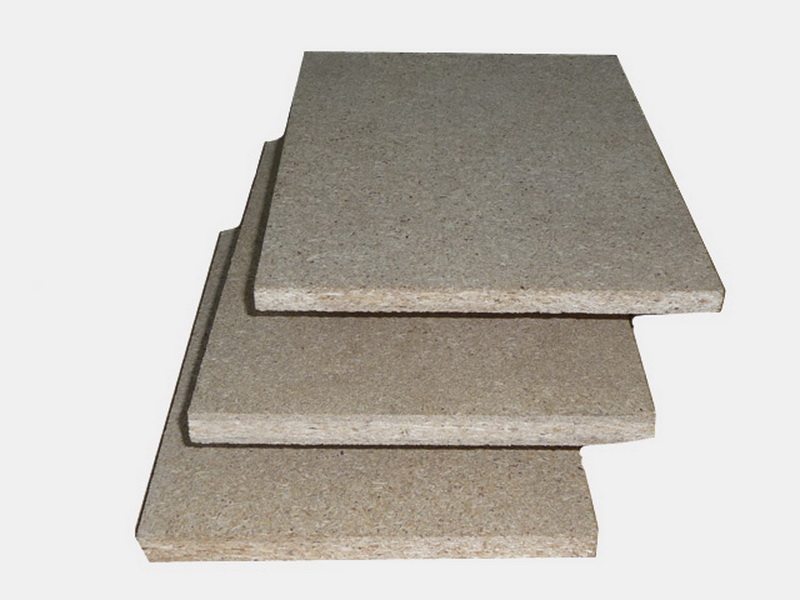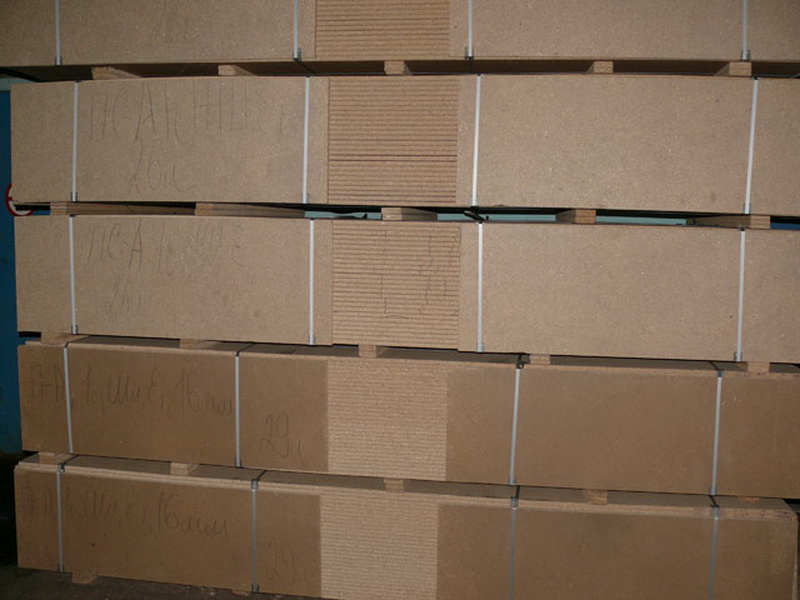Wood particle boards for general and special purposes are made by hot pressing of wood particles mixed with a binder. Wood particle boards are produced on the “Schenk” molding and pressing line, equipped with the “Becker-Van-Hullen” press (Germany). In 2004, the products were certified for compliance with the international standard requirements ISO 9001-2001, in 2005 they were certified according to the international standards of the ISO14000 series, in 2009 the occupational health and safety management system was introduced, meeting the requirements
of OHSAS-18001: 1999, NEQ.
Technological wood raw materials, sawdust and shavings are used as a raw feedstock. А low-toxic carbamide-formaldehyde KF-NFP resin is used аs a binder. The binder also includes a hardener based on ammonium sulfate and additives that reduce the emission of formaldehyde from finished plates, giving the plates special properties, the composition of which is protected by patents.
Wood particle boards GOST 10632-2007 “Particle board. Technical specifications” P-A grades, polished (for the production of furniture, in construction, in mechanical engineering, radio equipment and in the production of packaging);
Wood particle boards PS-A brands are intended for use in residential and civil construction for the production of built-in furniture, window boards, wall panel elements, floor coverings, formwork panels, temporary structures.
Wood particle boards GOST 10632-2007 grades P-A, (B) with increased moisture resistance, sanded. Thanks to special additives, they have increased resistance to both atmospheric moisture and moisture present in the place of use of products made of special-purpose plates.
Laminated pressed wood-fiber board laminated with decorative films chipboard grade P-A of all thicknesses, and increased moisture resistance. Laminated boards have a matte surface, a wide range of decors.
Laminated chipboard has all the advantages of a standard chipboard, but it is presented in a large number of color solutions. The material for making the plate is coniferous and deciduous wood. For lamination of chipboard, papers impregnated with melamine resins are used, which are applied under high temperature and pressure. Lamination can be either glossy or matte with a rough surface. Modern production technology makes it possible to give the surface of the plate the properties of thermosetting plastic with high resistance to mechanical and chemical influences.
LAMINATED CHIPBOARD PLATE – bring color variety to your life!
Individual order of decors by palette «Shattdecor», «Interprint» and «Impress» is possible.
|
Parameter name |
Nominal value |
| length, mm |
|
| width, mm |
|
| thickness, mm PA mark plate PS-A mark plate |
|
| straightness of edges |
|
| squareness of edges |
|
| density, kg / m3 |
|
| Bending strength, MPa for P-A plates with a thickness of 10 mm, 12 mm |
|
| Bending strength, MPa for P-A plates with a thickness of 16 mm, 18 mm |
|
| Bending strength, MPa for P-A plates with a thickness of 22 mm, 24 mm |
|
| Bending strength, MPa for P-A plates with a thickness 26 mm |
|
| Bending strength, MPa for PS-A plates with a thickness 18 mm |
|
| Swelling, % for P-A plates(all thicknesses) for P-A, B plates(all thicknesses, increased water resistance) for PS-A plates(18 mm thick) |
|
| Density, kg/m3 for P-A plates for PS-A plates |
|
| Formaldehyde emission class |
|
According to GOST 10632-2007, the first-class plates should not have recesses (projections) or scratches, paraffin, tar spots, chipping edges, grinding defects. All of the above defects, in turn, are limited for the second-class plates.
For avoiding of mechanical damage while loading and transportation, plates stacked in the following amounts:
P mark plate, thickness: 10±0,3 mm — 46 PCs
P mark plate, thickness: 12±0.3 mm — 39 PCs
P mark plate, thickness: 16±0,3 mm — 29 PCs
P mark plate, thickness: 18±0.3 mm — 26 PCs
P mark plate, thickness: 22±0,3 mm — 22 PCs
P mark plate, thickness: 24±0.3 mm — 20 PCs
P mark plate, thickness: 26±0.3 mm — 18 PCs
PS mark plate, thickness: 18±0.8 mm — 26 PCs
Packs of plates are lined with packing plates made of chipboard waste and then tightened with a packing tape (2 longitudinal and 4 transverse belts).








